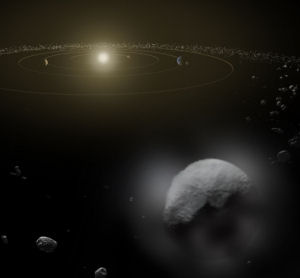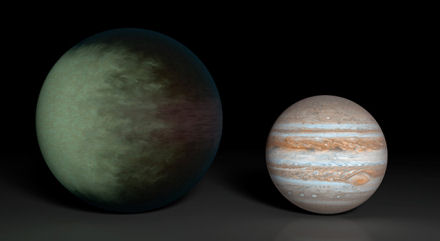
Titan’s thick, methane- and nitrogen-rich atmosphere has for many years kept astronomers from seeing what lies beneath. Saturn’s largest moon appeared through telescopes as a frustratingly hazy orange orb, in contrast to other heavily cratered moons in the solar system.
But in 2004, the Cassini-Huygens spacecraft penetrated Titan’s haze, providing scientists with their first detailed radar images of the surface. The images revealed an icy terrain carved out over millions of years by rivers of liquid methane, not dissimilar to how rivers of water have etched into Earth’s rocky continents.
While images of Titan have revealed its present landscape, very little is known about its geologic past. Now, however, researchers at MIT and the University of Tennessee have analyzed images of Titan’s river networks and determined that in some regions, the rivers have created surprisingly little erosion. The researchers say there are two possible explanations: either erosion on Titan is extremely slow, or some other recent phenomena may have wiped out older riverbeds and landforms.
“It’s a surface that should have eroded much more than what we’re seeing, if the river networks have been active for a long time,” says MIT’s Taylor Perron. “It raises some very interesting questions about what has been happening on Titan in the last billion years.”
Perron explained that compared to most moons in our solar system, Titan is relatively smooth, with few craters marking it. While Titan is about the same age as the rest of the solar system (4 billion years), the number of craters indicates that its surface is much younger, between 100 million and one billion years old.
What might explain this moon’s low crater count? The answer may be similar to what happens on Earth. “We don’t have many impact craters on Earth,” Perron says. “One explanation is that Earth’s continents are always eroding or being covered with sediment. That may be the case on Titan, too. For example, plate tectonics, erupting volcanoes, advancing glaciers and river networks have all reshaped Earth’s surface over billions of years. On Titan, similar processes – tectonic upheaval, icy lava eruptions, erosion and sedimentation by rivers – may be at work.”
Perron and MIT co-researcher Benjamin Black set out to determine the extent to which river networks may have renewed Titan’s surface. The team analyzed images taken from Cassini and mapped 52 prominent river networks from four regions on Titan. The researchers compared the images with a model of river network evolution developed by Perron. This model depicts the evolution of a river over time, given variables such as the strength of the underlying material and the rate of flow through the river channels. As a river erodes slowly through the ice, it transforms from a long, spindly thread into a dense, treelike network of tributaries.
Black compared his measurements of Titan’s river networks with the model, and found the moon’s rivers most resembled the early stages of a typical terrestrial river’s evolution. The observations, detailed in the Journal of Geophysical Research-Planets, indicate that rivers in some regions have caused very little erosion, and hence very little modification of Titan’s surface. “They’re more on the long and spindly side,” Black says. “You do see some full and branching networks, and that’s tantalizing, because if we get more data, it will be interesting to know whether there really are regional differences.”
Going a step further, Black compared Titan’s images with recently renewed landscapes on Earth, including volcanic terrain on the island of Kauai and recently glaciated landscapes in North America. The river networks in those locations are similar in form to those on Titan, suggesting that geologic processes may have reshaped the moon’s icy surface in the recent past. “It’s a weirdly Earth-like place, even with this exotic combination of materials and temperatures,” Perron says. “And so you can still say something definitive about the erosion. It’s the same physics.”
Related:
Discuss this article in our forum
Cassini tracks equatorial methane rainstorms on Titan
Strange Spot On Titan Baffles Boffins
Brewing a primordial broth on Titan


















Comments are closed.